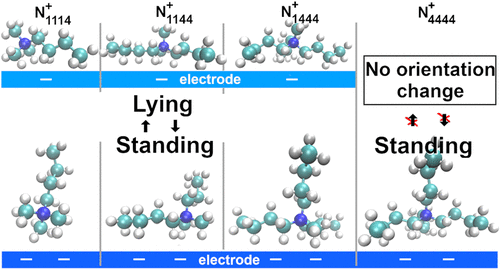当前位置:
X-MOL 学术
›
J. Phys. Chem. C
›
论文详情
Our official English website, www.x-mol.net, welcomes your
feedback! (Note: you will need to create a separate account there.)
Effect of Switching the Length of Alkyl Chains on Electric Double Layer Structure and Differential Capacitance at the Electrode Interface of Quaternary Ammonium-Based Ionic Liquids Studied Using Molecular Dynamics Simulation
The Journal of Physical Chemistry C ( IF 3.3 ) Pub Date : 2020-03-31 , DOI: 10.1021/acs.jpcc.0c00795 Seiji Katakura 1 , Naoya Nishi 1 , Kazuya Kobayashi 1 , Ken-ichi Amano 1, 2 , Tetsuo Sakka 1
The Journal of Physical Chemistry C ( IF 3.3 ) Pub Date : 2020-03-31 , DOI: 10.1021/acs.jpcc.0c00795 Seiji Katakura 1 , Naoya Nishi 1 , Kazuya Kobayashi 1 , Ken-ichi Amano 1, 2 , Tetsuo Sakka 1
Affiliation

|
Electric double-layer structure at the electrode interface has been studied by using molecular dynamics simulation on four quaternary ammonium-based ionic liquids (QaILs) to investigate the effect of switching the alkyl chain length of the Qa cation. These four QaILs are composed of a common anion, bis(trifluoromethanesulfonyl)- amide (TFSA–) and different cations: butyltrimethylammonium (N1114+, k = 1), dibutyldimethylammonium (N1144+, k = 2), tributylmethylammonium (N1444+, k = 3), and tetrabutylammonium (N4444+, k = 4), where k represents the number of butyl chains. The difference in k affects the potential dependence for the composition of the first ionic layer and the orientation of butyl chains in the layer. For the case of k = 1, 2, 3, the butyl chains parallel to the interface increases as the potential becomes negative, but further negative potential results in the increase in perpendicular ones. In the case of k = 1, all the cations in the first ionic layer show the perpendicular orientation at the negative potentials, forming a honeycomb lattice consisting of only cations. On the other hand, in the case of k = 4, no change in orientation has been observed due to the geometrical restrictions. The difference in k also affects the differential capacitance. The potential dependence of differential capacitance shows bell shape for the smaller two (k = 1, 2) and camel shape for the larger two (k = 3, 4). The camel shape for larger IL cations agrees with the prediction from the mean-field lattice gas model and recent experimental results. The differential capacitance at negative potentials deviated to the values higher than the model prediction and the discrepancy becomes greater for smaller k. The results indicate that the potential dependence of ionic orientation significantly affects the differential capacitance. Even for k = 4, which does not show the orientational change, the discrepancy has been observed, indicating that not only the orientational change but also the densification of ions in the first ionic layer are the factors we should take into account beyond the lattice gas model.
中文翻译:

分子动力学模拟研究烷基烷基链长度的变化对季铵盐基离子液体电界面双电层结构和微分电容的影响
通过对四种季铵基离子液体(QaIL)进行分子动力学模拟,研究了电极界面处的双电层结构,以研究切换Qa阳离子的烷基链长的影响。这四个QaIL由共同的阴离子,双(三氟甲磺酰基)-酰胺(TFSA –)和不同的阳离子组成:丁基三甲基铵(N 1114 +,k = 1),二丁基二甲基铵(N 1144 +,k = 2),三丁基甲基铵(N 1444)+,k = 3)和四丁基铵(N 4444 +,k = 4),其中k代表丁基链的数量。k的差异影响第一离子层的组成和层中丁基链的取向的电势依赖性。对于k = 1、2、3的情况,与界面平行的丁基链随着电势变为负而增加,但进一步的负电势导致垂直的丁基链增加。在k= 1的情况下,第一离子层中的所有阳离子在负电势处显示垂直取向,从而形成仅由阳离子组成的蜂窝晶格。另一方面,在k= 4的情况下,由于几何限制,未观察到取向变化。k的差也影响差分电容。差分电容的电势依赖性显示较小的两个钟形(k = 1,2)和较大的两个钟形骆驼(k = 3,4)。较大的IL阳离子的骆驼形状与平均场晶格气体模型的预测和最近的实验结果一致。负电势下的差分电容偏离的值高于模型预测值,并且对于较小的k,差异变得更大。结果表明,离子取向的电势依赖性显着影响差分电容。即使对于k = 4,其没有显示出取向变化,已经观察到差异,表明不仅取向变化而且第一离子层中离子的致密化也是我们除了晶格气体模型之外还应考虑的因素。
更新日期:2020-03-31
中文翻译:

分子动力学模拟研究烷基烷基链长度的变化对季铵盐基离子液体电界面双电层结构和微分电容的影响
通过对四种季铵基离子液体(QaIL)进行分子动力学模拟,研究了电极界面处的双电层结构,以研究切换Qa阳离子的烷基链长的影响。这四个QaIL由共同的阴离子,双(三氟甲磺酰基)-酰胺(TFSA –)和不同的阳离子组成:丁基三甲基铵(N 1114 +,k = 1),二丁基二甲基铵(N 1144 +,k = 2),三丁基甲基铵(N 1444)+,k = 3)和四丁基铵(N 4444 +,k = 4),其中k代表丁基链的数量。k的差异影响第一离子层的组成和层中丁基链的取向的电势依赖性。对于k = 1、2、3的情况,与界面平行的丁基链随着电势变为负而增加,但进一步的负电势导致垂直的丁基链增加。在k= 1的情况下,第一离子层中的所有阳离子在负电势处显示垂直取向,从而形成仅由阳离子组成的蜂窝晶格。另一方面,在k= 4的情况下,由于几何限制,未观察到取向变化。k的差也影响差分电容。差分电容的电势依赖性显示较小的两个钟形(k = 1,2)和较大的两个钟形骆驼(k = 3,4)。较大的IL阳离子的骆驼形状与平均场晶格气体模型的预测和最近的实验结果一致。负电势下的差分电容偏离的值高于模型预测值,并且对于较小的k,差异变得更大。结果表明,离子取向的电势依赖性显着影响差分电容。即使对于k = 4,其没有显示出取向变化,已经观察到差异,表明不仅取向变化而且第一离子层中离子的致密化也是我们除了晶格气体模型之外还应考虑的因素。









































 京公网安备 11010802027423号
京公网安备 11010802027423号